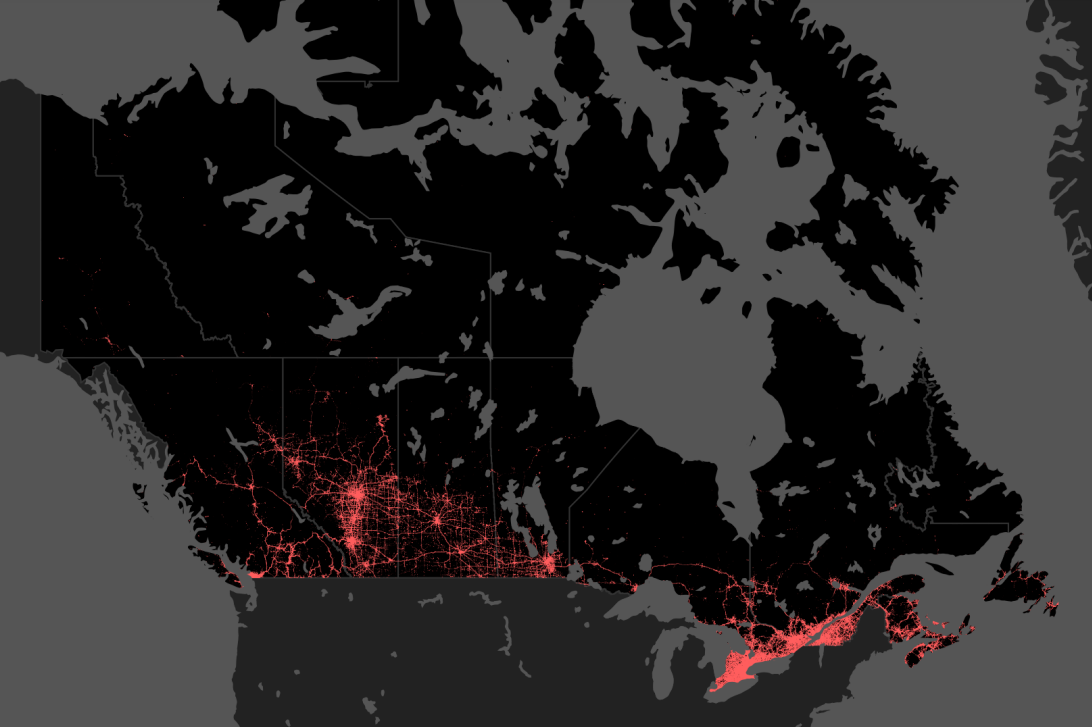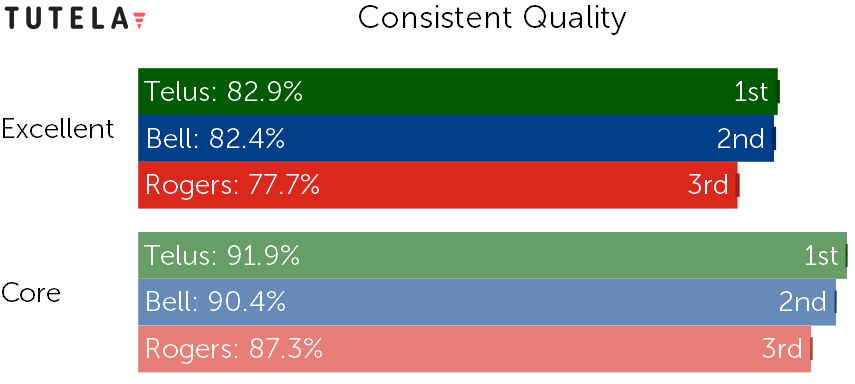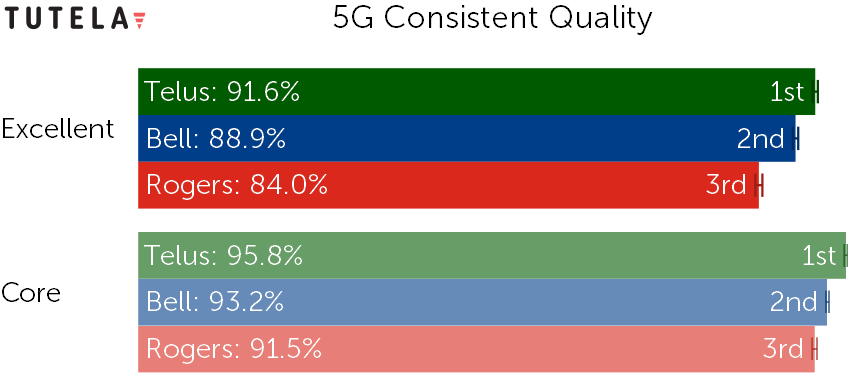Canada
State of Mobile Experience
March 2022
State of Mobile Experience
March 2022
In our annual benchmark report for Canada, we have evaluated 879,152 speed and latency tests, conducted on the smartphones of real-world users of national mobile operators within Common Coverage Areas, between September 2021 and February 2022.
In the past two years, the COVID-19 pandemic has affected almost every business and industry around the world and the telecoms industry was no exception. On one hand, the demand for telecoms services increased exponentially, while several activities critical to infrastructure development and capacity enhancement such as spectrum auctions were derailed due to the pandemic. This however was not the case for the Canadian telecoms market which saw several major events throughout 2021.
A major spectrum auction for the 3500 MHz band was concluded in July 2021 where all three major operators Bell, Rogers and Telus acquired spectrum and the government raised $8.9 billion. In December 2021, the government also announced consultation for a 3800 MHz spectrum auction policy and licensing framework. The second major event that has been in the headlines is the acquisition of Calgary based wireless provider Shaw by Rogers Communications Inc. The deal is still under regulatory reviews and is yet to close.
Canadian operators have also been progressing steadily in terms of 5G deployment. As of January 2022, Telus claimed to have connected 744 urban and rural communities to 5G covering 70% of the Canadian population. Meanwhile, Rogers has recently claimed that it expanded its 5G network to ten new communities under the Eastern Ontario Regional Network Project. Regional players have also started 5G deployment in the country. In a recent announcement, Sasktel said that it rolled out 5G services in Saskatoon and expanded its 5G network to 15 more towers in Regina. Additionally, Eastlink recently announced the rollout of its 5G network in partnership with Ericsson activating 18 sites in Halifax, Nova Scotia.
Report statisticsDate range: 1 September 2021 - 28 February 2022 Download & response tests = 879,152 Operators
Bell |
Report statistics

Discover the top performing operators in our mobile experience results table.
-1.png?width=700&name=2021%20Awards%20table%20(19)-1.png) The contents of this report and the awards shown above are copyright Tutela; organizations may republish the awards and results above for editorial purposes; non-commercial uses and on unsponsored social media posts. For all other uses, please contact awards@tutela.com.
The contents of this report and the awards shown above are copyright Tutela; organizations may republish the awards and results above for editorial purposes; non-commercial uses and on unsponsored social media posts. For all other uses, please contact awards@tutela.com.
This report encompasses the following experience KPIs:
To ensure a fair comparison between operator performance, Tutela limits the results used in our comparisons to those collected within Common Coverage Areas.
Learn more about our benchmarking methodology here.
Telus had the highest Excellent Consistent Quality with 82.9% of connections good enough for demanding applications like 1080p video streaming, HD group video calling and real time mobile gaming In Common Coverage Areas across Canada. Bell was close behind narrowly missing first place with an Excellent Consistent Quality of 82.4%. While competition between Telus and Bell was extremely tight, the gap between Rogers and the other operators was much wider. Rogers trailed behind the others by about 5 percentage points with an Excellent Consistent Quality of 77.7%.
With a score of 91.9%, Telus took the lead for Core Consistent Quality, Tutela’s metric that represents the percentage of the time that our users’ average experience met the minimum recommended performance thresholds for lower performance applications including SD video, voice calls and web browsing. Bell placed second, missing the top spot by a mere 1.5 percentage points while Rogers placed third at 87.3%.
Network performance across all three operators saw a substantial improvement in terms of 5G Consistent Quality. The trend continued here with Telus in the lead for both Excellent and Core Consistent Quality. The operator had an Excellent Consistent Quality of 91.6%, an improvement of 8.7 percentage points over overall Excellent Consistent Quality. Bell placed second at 88.9%, trailing behind Telus by 2.7 percentage points. When compared to overall Excellent Consistent Quality, Bell had an improvement of 6.5 percentage points when connected to 5G. Rogers placed third with an Excellent Consistent Quality of 84.0%, an improvement of 6.3 percentage points on a 5G network.
Looking at Core Consistent Quality, Telus topped the leaderboard at 95.8% with an improvement of 3.9 percentage points over overall Core Consistent Quality performance. Trailing by 2.6 percentage points, Bell placed second at 93.2%, an increase of 2.8 percentage points from Bell’s overall Core Consistent Quality. At 91.5%, Rogers placed third with an improvement of 4.2 percentage points when connected to a 5G network.


The table below shows a breakdown of individual KPIs for each operator.
| Bell | Rogers | Telus | |
| Download % above 5 Mbps | 94.7% | 92.0% | 95.3% |
| Upload % above 1.5 Mbps | 95.6% | 93.2% | 96.2% |
| Latency % below 50 ms | 99.4% | 97.8% | 99.6% |
| Jitter % below 12 ms | 98.6% | 98.9% | 98.6% |
| Packet discard % below 1% | 97.6% | 97.6% | 96.3% |
The table below shows a breakdown of individual KPIs for each operator for 5G only.
| Bell | Rogers | Telus | |
| Download % above 5 Mbps | 98.9% | 94.6% | 99.2% |
| Upload % above 1.5 Mbps | 98.8% | 98.1% | 98.8% |
| Latency % below 50 ms | 99.8% | 98.8% | 99.6% |
| Jitter % below 12 ms | 98.7% | 98.0% | 98.9% |
| Packet discard % below 1% | 97.2% | 95.1% | 97.5% |
At Tutela we take data privacy seriously and do not collect any sensitive personal information. Please read our Privacy Charter (PDF) to learn more. Opt out (Do Not Sell My Info)
+1 (855) 6-TUTELA